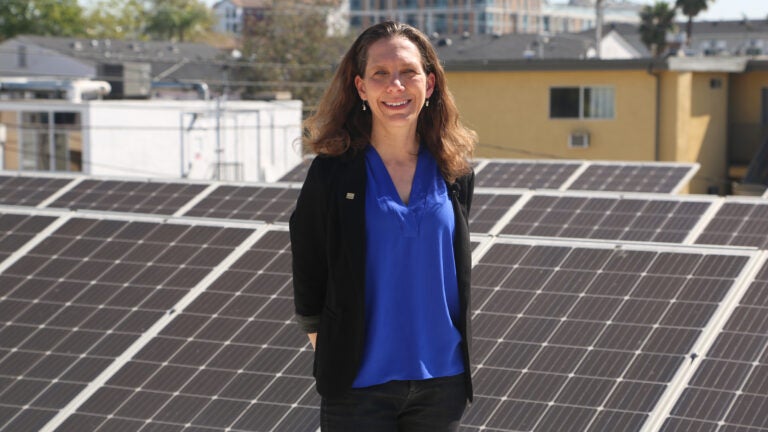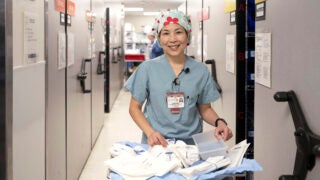
Zelinda Welch has played a key role in USC’s emergence as a trailblazer in sustainability. (USC Photo/ Stephen Gee)
USC’s trailblazing sustainability success: Q&A with USC Director of Energy and Sustainability Zelinda Welch
EARTH MONTH: Zelinda Welch discusses how USC has transformed into a leader in sustainability and the challenges ahead.
Zelinda Welch has played a key role in USC’s emergence as a trailblazer in sustainability. As the university’s director of energy and sustainability, she has contributed to numerous university initiatives focused on minimizing waste and energy consumption.
USC is making significant progress toward the goals outlined in Assignment: Earth, USC President Carol Folt’s ambitious sustainability framework, established in 2022. The university has reduced its greenhouse gas emissions (scope 1 and 2) by 50% compared to 2014 levels and cut water use by more than 25%. USC’s waste diversion rate has doubled in five years thanks to the introduction of more than 1,000 multi-stream wastebins.
In 2022, Sustainable Design and Construction Guidelines were established mandating all new university building projects are designed with sustainability in mind. The same year, a partnership with the Los Angeles Department of Water and Power was reached, ensuring 25% of USC’s electricity comes from solar-generated power.
This Earth Month, USC News spoke with Welch, who graduated from the USC Marshall School of Business with an MBA in 2008, about how the university has transformed its approach toward sustainability.
What were the sustainability priorities for USC when you started working here?
Welch: When I started at USC about six years ago, there were already sustainability initiatives in place, such as zero-waste athletic events and efforts to track our greenhouse gas footprint. However, sustainability had not yet been established as a comprehensive, universitywide priority. This presented an exciting opportunity to define a clear vision, create a structured strategy and unify efforts across the institution to drive meaningful progress.
How have USC’s sustainability priorities changed over time?
Welch: Over time, our priorities have evolved to emphasize a unified, institutionwide commitment to sustainability. A significant shift occurred with the arrival of USC President Carol Folt, who established the USC President’s Working Group on Sustainability (PWG) to bring together stakeholders from across the university. This effort led to the creation of Assignment: Earth, USC’s comprehensive sustainability framework, which was institutionalized in 2022. The framework set a clear vision and introduced 29 SMART goals spanning five key domains: education, research, inclusion, operations and engagement. By publicly committing to these goals, USC solidified our role as a leader in sustainability, demonstrating a long-term commitment to environmental and social responsibility.
What have been some of the major challenges you have faced?
Welch: Together, our Trojan community has made many advances. After lunch meetings, colleagues often approach me with questions on how to best sort their waste into the three-stream bins (waste, recycling and compost). People want to do the right thing and are open to learning. Even small behavior changes like sorting waste make a difference.
While we’ve made significant strides in addressing the more immediate, straightforward sustainability challenges, we are now reaching a point where USC must confront more complex issues. As we check off these “easier wins,” we are encountering larger challenges, including major infrastructure projects or more significant behavior changes. The next phase will require us to creatively and resourcefully identify the best approaches for tackling these deeper, more resource-intensive investments. Prioritizing specific efforts and ensuring we approach them efficiently and effectively will be critical as we continue to push forward in our sustainability journey.
What are you most proud of?
Welch: Watching the crane lift the first set of solar modules numerous stories to the top of the Galen Center in March 2020 was one of my proudest moments. Despite the onset of COVID and the immense challenges it brought, teams across USC came together to ensure the university’s largest solar installation became a reality. From there, progress continued onward, whether it was more solar arrays on other rooftops silently pumping out clean power or outdated lighting replaced with energy-efficient LEDs in spaces from grand auditoriums to hidden closets. Across [the University Park Campus], teams persist in driving projects both large and small, visible and behind the scenes, all contributing to a more sustainable future.
What sustainability changes can we expect going forward?
Welch: USC is making significant strides in sustainability, with numerous initiatives already underway. Our teams are leveraging comprehensive datasets and insights into lessons learned to enhance and accelerate our efforts. Key initiatives include expanding zero-waste programs through increased bin installations, converting more landscape areas to native and climate-adaptive plants, advancing rooftop solar PV installations and conducting additional energy audits across campus buildings. With a clear vision, a strong portfolio of projects and dedicated teams of contributors, USC is committed to making meaningful progress in sustainability. The momentum is building, and I’m proud to be part of this journey, excited for what’s ahead and eager to contribute to USC’s greener future.



